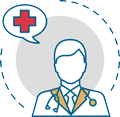Testicular Cancer
"After treatment for testicular cancer, it is very important to have regular check-ups".
DR. FERNANDO JOSÉ DIEZ-CABALLERO
SPECIALIST. UROLOGY DEPARTMENT

Testicular cancer is a type of cancer that originates in the testicles. The testicles are two organs that are part of the male reproductive system and are responsible for generating spermatozoa.
This type of tumour originates, in 90% of cases, in testicular cells called germ cells. There are two main types of germ cell tumours: seminomas and non-seminomas.
The causes of testicular cancer are unknown, as are the risk factors that may favour the development of this type of tumour. The main risk factor is the lack of descent of the testicle at birth (cryptorchidism).
Other factors that have been associated with the development of testicular cancer include high maternal hormone levels during pregnancy and premature birth, trauma to the testicle and a family history of testicular cancer.

A PERSONALIZED MEDICINE
Second Opinion,
peace of mind
Request a second opinion from our professionals with great experience in the diagnosis and treatment of oncological diseases
In 3 days, without leaving home.
Symptoms of testicular cancer
Testicular lump
The vast majority of testicular tumours are diagnosed by the appearance of a lump in the testicle, which is often painless. In cases where there is pain, it usually appears progressively, although it may appear suddenly if the tumour becomes complicated.
Breast enlargement
Breast enlargement may occur in males due to an increase in Beta Chorionic Gonadotropin, a hormone that only increases in males in some cases of testicular tumours.
Pain
In some patients there may be pain in the back or abdomen, caused by painful stimuli from the testicle being directed there or by lymph node metastases in the retroperitoneum.
Other
In cases where there are metastases in other organs (lung, brain, bone, etc.), these can produce very varied symptoms, depending on their location.
Do you have any of these symptoms?
If you suspect that you have any of the above symptoms,
you should consult a medical specialist for a diagnosis.
Types of testicular cancer
There are two main types of testicular cancer that are important to differentiate as the treatment scheme is different:
- Seminoma: These are tumours that should not be mixed with other tumour types, they account for 40% of testicular tumours and are most common during the fourth decade of life. These tumours are more sensitive to radiotherapy than other testicular tumours.
- Nonseminoma: Nonseminomatous tumours account for 60% of testicular cancers and usually occur during the third decade of life.
Stages of testicular cancer
- Stage I: The tumour only affects the testicle.
- Stage II: The tumour spreads to lymph nodes, usually located in the retroperitoneum (the area behind the abdomen). There are no metastases.
- Stage III: The tumour has metastases or very significant elevation of tumour markers.
How is testicular cancer diagnosed?
The diagnosis of testicular cancer is made on the basis of a detailed clinical history and a physical examination by a specialist.
If a mass is detected on palpation, a blood test (with detection of alpha-fetoprotein and beta-HCG, tumour markers that are elevated in these patients) and a testicular ultrasound scan are necessary to determine the characteristics of the tumour and whether the other testicle is affected.
The study should be completed with additional imaging tests: abdominal CT scan, bone scintigraphy and PET scan, to assess whether the tumour affects neighbouring structures or has even spread to distant areas.
Treatment of testicular cancer
Treatment will depend on the type of tumor the patient has and the stage of the tumor.
The initial treatment will always be surgical, even when the cancer has spread, surgical removal of the testicle is also indicated.
This treatment can be complemented with adjuvant chemotherapy and/or radiotherapy to slow progression and prevent relapse. The chemotherapy drug used is carboplatin, which is reasonably tolerated and very effective in this type of tumor.
In the check-ups, in addition to the collection of symptoms and physical examination, a determination of tumor markers is usually performed.
In addition, a chest X-ray, abdominal CT scan and testicular ultrasound are usually performed periodically.
The frequency of check-ups is usually variable and their duration should be lifelong, since there is a small risk of developing tumors in the healthy testicle.
Where do we treat it?
IN NAVARRA AND MADRID
The Department of Urology
of the Clínica Universidad de Navarra
The Department of Urology of the University of Navarra Clinic offers the patient a medical team, composed of first-rate professionals, and state-of-the-art diagnostic and therapeutic means such as the Da Vinci® robotic surgery.
The Department of Urology possesses the certificate of accreditation of the European Board of Urology, a reinforcement of the excellence of the service at the level of care, teaching and research, which in Spain only three hospital centers possess.
Diseases we treat:
- Prostate Cancer
- Kidney Cancer
- Bladder Cancer
- Testicular Cancer
- Benign prostatic hyperplasia
- Urinary Incontinence
- Renal Lithiasis
- Genitourinary Prolapses
- Pediatric Urology

Why at the Clinica?
- A team of top-level professionals trained in international centers.
- State-of-the-art technology for diagnosis and treatment.
- In 24-48 hours you can start the most appropriate treatment.

































